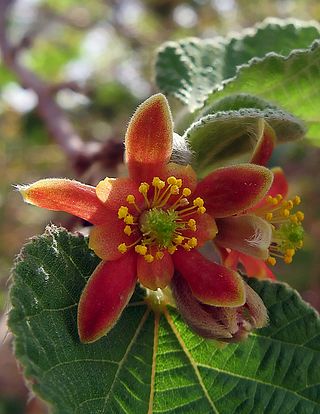
Grewia villosa is a shrub, often scrambling and hardly exceeding 4 m in height. Leaves are fairly large, serrated and heart-shaped. It grows naturally, mainly in dry habitats. It is common in most of the semi-arid parts of Eastern Africa but may now be rare in parts of its natural distribution. It can be seen in Ein Gedi oasis in Israel, and in South Africa, where it is common. Its ripe copper-coloured fruits are eaten in East Africa.

Nepenthes villosa, or the villose pitcher-plant, is a tropical pitcher plant endemic to Mount Kinabalu and neighbouring Mount Tambuyukon in northeastern Borneo. It grows at higher elevations than any other Bornean Nepenthes species, occurring at elevations of over 3,200 m (10,500 ft). Nepenthes villosa is characterised by its highly developed and intricate peristome, which distinguishes it from the closely related N. edwardsiana and N. macrophylla.
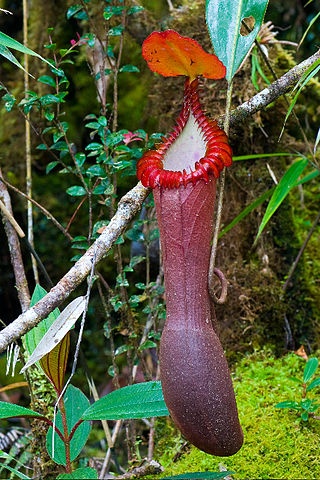
Nepenthes edwardsiana, or the splendid pitcher-plant, is a carnivorous tropical pitcher plant endemic to Mount Kinabalu and neighbouring Mount Tambuyukon in Sabah, Malaysian Borneo. It is considered one of the most spectacular of all Nepenthes, producing some of the largest pitchers and the most highly developed peristome ribs of any species in the genus.

Acaciella villosa is a species of legume in the family Fabaceae. It is found only in Jamaica.
Scalesia villosa is a species of flowering plant in the family Asteraceae. It is found only in Ecuador. It is threatened by habitat loss.
Chusquea villosa is a species of bamboo endemic to Ecuador.

The Chinese nuthatch or snowy-browed nuthatch is a species of bird in the family Sittidae. It is a small nuthatch, measuring 11.5 cm (4.5 in) in length. The upperparts are blue-gray and the underparts from a dull buff-grayish to a cinnamon-orange; the cheeks are white. There is a marked sexual dimorphism: the adult male is distinguished by its very black crown, while that of the female is the same blue-grey as the back, or at most dark gray when the plumage is worn. In both sexes, a dark gray eyestripe extends in front of and behind the eye, topped by a clear white supercilium separating it from the crown. The song is variable, and composed of repetitions of small invariant whistles. The species feeds mainly on insects in summer and completes its diet with seeds and fruits. The nest is generally placed in the hole of a conifer. The pairs raises one brood per year, with five or six chicks.
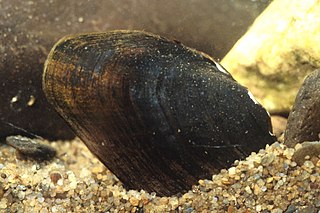
Villosa trabalis, the Cumberland bean pearly mussel, Cumberland bean, or purple bean, is a species of freshwater mussel, an aquatic bivalve mollusk in the family Unionidae.
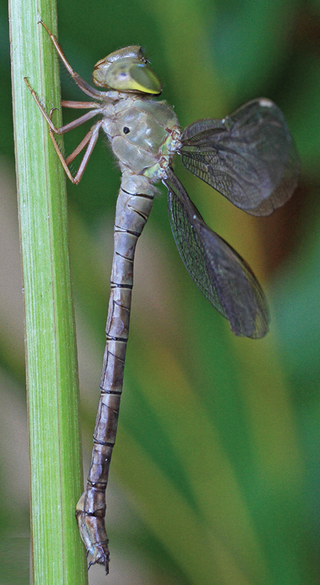
Gynacantha villosa is a species of dragonfly in the family Aeshnidae. It is found in Botswana, Burundi, Central African Republic, the Democratic Republic of the Congo, Ethiopia, Kenya, Malawi, Mozambique, South Africa, Tanzania, Uganda, Zambia, and possibly Burkina Faso. Its natural habitats are subtropical or tropical moist lowland forests and shrub-dominated wetlands.
Gordonia villosa is a species of plant in the family Theaceae. It is endemic to Jamaica.
Isonandra villosa is a species of plant in the family Sapotaceae. It is native to Kerala and Tamil Nadu in India. It is threatened by habitat loss.
Kibatalia villosa is a species of plant in the family Apocynaceae. It is found in Indonesia and Malaysia.
Saurauia villosa is a species of plant in the Actinidiaceae family. It is endemic to the Mesoamerican countries of Mexico, Guatemala, El Salvador, and Honduras. It is a small tree found in cloud forests, as well as pine-oak forests and secondary forests.

Wikstroemia villosa, the hairy wikstroemia or hairy false ohelo, is a tropical species of plant in the Thymelaeaceae family.

Villosa taeniata, the painted creekshell, is a species of freshwater mussel, an aquatic bivalve mollusk in the family Unionidae.

The hairy-tailed antsangy is a species of rodent in the family Nesomyidae. It is found only in Madagascar.

Wurfbainia villosa, also known by its basionym Amomum villosum, is a plant in the ginger family that is grown throughout Southeast Asia and in South China. Similar to cardamom, the plant is cultivated for its fruits, which dry into pods when mature and contain strongly aromatic seeds. W. villosa is an evergreen plant in the ginger family, grow in the shade of the tree, 1.5 to 3.0 m high, whose branches and leaves are similar to ginger's. W. villosa has a characteristic that flowers spread on the ground can bear fruit while flowers on the branches can not. Its flowers bloom in March and April and are the colour of white jade.
The Choctaw bean is a species of freshwater mussel, an aquatic bivalve mollusc in the family Unionidae. This species is found in the southeastern United States and is currently on the endangered species list. The species epithet and the common name are based on the name of the Choctaw people, Native Americans who were originally from the southeastern United States.
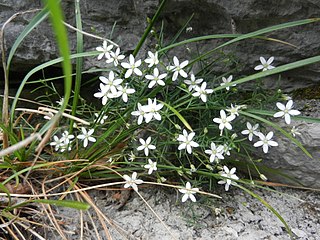
Moehringia villosa, commonly known as the short-haired sandwort, is a flowering plant of the genus Moehringia. It is endemic to Slovenia where it has a very limited range with an extent of occurrence of less than 1,000 square kilometres (390 sq mi) in the southern parts of the Julian Alps. It grows in cracks in sunny, rocky and dry areas.

Serruria villosa, the golden spiderhead, is a flower-bearing shrub that belongs to the genus Serruria and forms part of the fynbos. The plant is native to the Western Cape, where it occurs only on the Cape Peninsula and just south of Constantia. The shrub is erect and grows only 50 cm tall and bears flowers from April to July.














